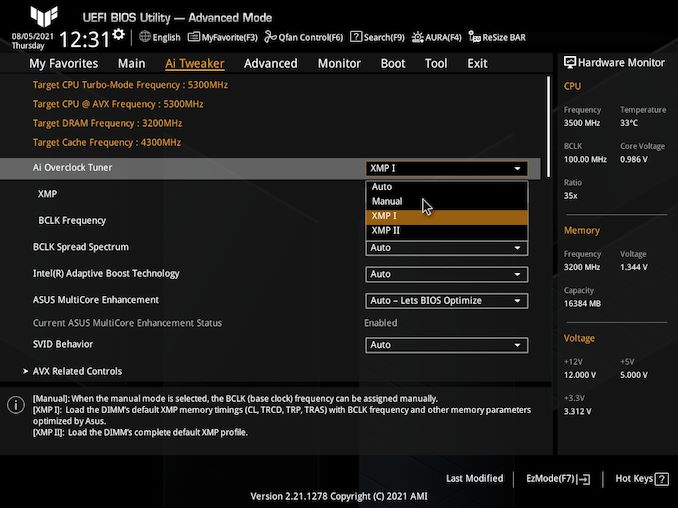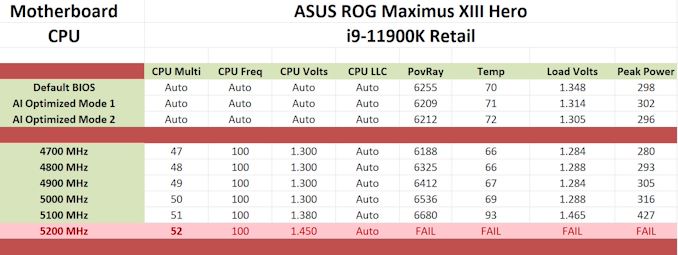ASUS TUF Gaming Z590-Plus WIFI Motherboard Review: Is $260 Mid-Range or High-End?
by Gavin Bonshor on August 10, 2021 10:00 AM ESTOverclocking
The art of overclocking can be considered a skill. Getting the right combination of settings to deliver an optimized yet stable enough system to deliver the performance can be time-consuming and tedious. Despite the excellent work from both Intel and AMD over the last couple of years with its interpretations of 'turbo' and 'boost,' this doesn't typically affect all of the cores and instead focuses on one or two. On an eight-core processor such as the Intel Core i9-11900K, providing whatever software of application is being used can utilize the cores and threads, typically more performance can be had from pushing all of the cores higher. At present, Intel employs some of the most aggressive methods of automatic overclocking with its Thermal Velocity Boost (TVB), and more recently with Rocket Lake, its new Adaptive Boost Technology (ABT) on its 11th Gen Core i9 K and KF processors.
Perhaps the biggest disadvantage when it comes to overclocking the processor has to deal with the extra heat and power implications. As Intel pushes its silicon almost to its limit right out of the factory, adequate cooling is needed. Due to previous experiences when overclocking our i9-11900K in previous Z590 reviews, we've seen power consumption figures surpassing 350 W when overclocking, which is a phenomenal amount of wattage for an eight-core chip. Even at default settings, new processors from both Intel and AMD typically run warmer than previous generations. Hence, we recommend using premium cooling solutions such as AIO CPU coolers or even large tower coolers to help manage the extra heat generated.
Experience with the ASUS TUF Gaming Z590-Plus WIFI
Overclocking with the ASUS TUF Gaming Z590-Plus WIFI is made easier due to the layout of the firmware. All of the relevant overclocking options can be found within the Ai Tweaker section within the Advanced section of the BIOS. In the AI Tweaker section, users can overclock the CPU, the iGPU, memory, and the board's base clock generator (BCLK). For the CPU, users can adjust the CPU Core frequency, and make necessary adjustments to the CPU VCore, which when manually overclocking, are the two most important settings to consider. More advanced users may want to alter the BCLK, which overclocks the CPU and memory, and pushing this too high can cause system instability. There's plenty of options to adjust Intel's Adaptive and Thermal Boost technologies, as well as adjust the loadline calibration settings which can improve system under load, with a higher level profile designed to improve the power and voltage throughput to the CPU under full load.
For overclocking the memory, users can simply enable X.M.P 2.0 profiles on compatible memory, or perform manual overclocks. While we recommend sticking to the X.M.P 2.0 profiles for everyday systems, for advanced users, there are options for altering the memory frequency ratio, lots of latency options in the advanced DRAM settings menu, and adjusting Intel's Geared Memory Mode. IGM allows users to select between a 1:1 or 2:1 ratio, which when selecting the latter, can allow for higher memory frequencies to be used as it puts less pressure on the integrated memory controller (IMC).
Overall the ASUS TUF firmware is like many other variants of its firmware (ROG/Strix) and offers a familiar GUI. For a model of this pedigree (mid-range), there's plenty of options for users looking to overclock, and it ticks all of the boxes.
Overclocking Methodology
Our standard overclocking methodology is as follows. We select the automatic overclock options and test for stability with POV-Ray and Prime95 to simulate high-end workloads. These stability tests aim to catch any immediate causes for memory or CPU errors.
For manual overclocks, based on the information gathered from the previous testing, start off at a nominal voltage and CPU multiplier, and the multiplier is increased until the stability tests are failed. The CPU voltage is increased gradually until the stability tests are passed. The process is repeated until the motherboard reduces the multiplier automatically (due to safety protocol) or the CPU temperature reaches a stupidly high level (105ºC+). Our testbed is not in a case, which should push overclocks higher with fresher (cooler) air.
Overclocking Results
Using the ASUS TUF Gaming Z590-Plus WIFI to overclock our Core i9-11900K yielded some interesting results. ASUS doesn't include any predefined OC profiles per se, but it does include its AI Optimization settings, which didn't really show any benefits over default settings in our POV-Ray benchmark results.
When manually overclocking our POV-Ray results went up incrementally as we tested each frequency from 4.7 GHz to 5.1 GHz. Normally we can easily achieve 5.2 GHz and sometimes 5.3 GHz stable with our testbed processor, but the TUF Gaming Z590-Plus wouldn't stabilize beyond 5.1 GHz despite using ample CPU VCore voltage. Testing from 4.7 to 5.0 GHz, we saw relatively tight VDroop control compared to what we set CPU VCore we set in the firmware to what we got at full-load. At 5.1 GHz, the VDroop did get a little overzealous with 1.465 V at full load, compared to the 1.38 V we had set within the firmware.
Touching on our general experience in our testing, we feel the TUF Gaming Z590-Plus WIFI could do better, especially as we know our Core i9-11900K can do 5.2 GHz all-cores easily, and we can even get 5.3 GHz on some of the more 'focused' models.












23 Comments
View All Comments
Holliday75 - Tuesday, August 10, 2021 - link
I have not used a soundcard in almost 15 years. Have not seen the point. If I want audiophile sound I'll go listen to my $3200 tower speakers.MDD1963 - Wednesday, August 11, 2021 - link
Intel's 845G chipset for the Pentium III/850 (I bought it around Christmas of the year 2000) has usable onboard sound for gaming. Have not bought a sound card since 1999 or so...Qasar - Wednesday, August 11, 2021 - link
i still use soundcards, mosty because onboard sound, doesnt have dd live or dts connect, and if it does, it isnt as good as the sb z or the sb ae-5 plus i now have. the last on board sound i used, was with the n force 2, and briefly with the a64 i had.blppt - Thursday, August 12, 2021 - link
I think the vast majority use the sound over the HDMI/DP out on the video card (then from the monitor/line out), at least in most setups i've seen.Then, if you want higher quality sound for your cans, people buy outboard DACs/headphone amps like the FiiOs, which are far superior to any motherboard solution anyways.
Leeea - Wednesday, August 11, 2021 - link
I doEveryone I know does.
Oxford Guy - Wednesday, August 11, 2021 - link
‘In our overclock testing, the board’s inability to hit 5.2 GHz all-core stable with our Core i9-11900K processor was somewhat disappointing. Even with a hefty 1.45 V on the CPU VCore, it just didn’t want to play ball’Overclocking Rocket Lake?
I hope you had one of those Intel freezer units the company used to demo some time ago.
Overclocking is dead. It has zero relevance, zero practicality. Modern turbo has eliminated the point.
Moreover, Rocket Lake’s critical flaw is its 14nm power hog process. Overclocking magnifies that.
Finally, it’s a mistake to entice people to pump reckless amounts of voltage into expensive hardware. It’s hilarious, too, given this site’s defense of its use of JEDEC RAM speeds to hobble Zen 1 and 2 in reviews.
Most people, you claimed, don’t open BIOS to switch on XMP. But, apparently trying to overclock Rocket Lake (with or without reckless levels of voltage) is so much more relevant.
The amount of effort, expertise, and time involved in overclocking to obtain stability, rather than useless Cinebench scores, is vastly vastly more than what is needed to switch on a single BIOS setting (XMP).
Nfarce - Monday, August 16, 2021 - link
That is one of the most ignorant things I've read here in my 20 years of being on AT. You do realize that turbo boost is rated around CORES USED right? So for example that hot 5.3 "turbo" boost on this i9 is for TWO cores not ALL EIGHT. And there are countless examples of why overclocking for ALL CORES is still relevant today. Stop spreading FUD because you don't know how to successfully overclock.Oxford Guy - Thursday, August 19, 2021 - link
The laws of physics disagree with your rant.As for the ad hom at the end, I’m quite sure that’s the reason — not that overclocking is dead.
Nfarce - Friday, August 27, 2021 - link
So you don't refute that your "point" is without merit (or benchmarks, or any other back up proof). Keep talking and showing your ignorance. The facts and benchmarks on overclocking on ALL cores for productivity alone prove you wrong.Oxford Guy - Wednesday, August 11, 2021 - link
So... Did ‘14 nm’ appear anywhere on the first page or did 1.45 volts appear instead?The relevance... the priorities...